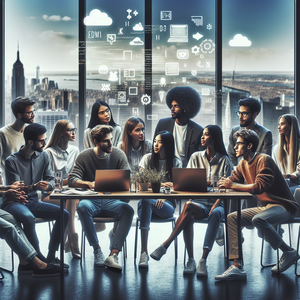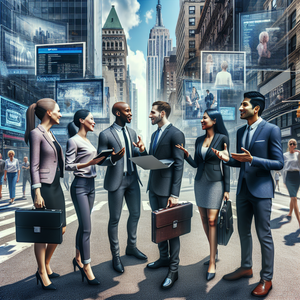The Intersection of Art and Electronics in New York

The marriage of art and electronics manifests in various innovative projects that challenge traditional perceptions of both fields. One prominent example is the partnership between the tech company Raspberry Pi and artists who leverage their microcomputers to create interactive installations. These projects often engage viewers in new ways, allowing them to become part of the artwork. At the New Museum, for instance, interactive exhibits employ Raspberry Pi to create installations where visitors can manipulate digital art through physical interaction. This effectively transforms the audience into co-creators, fostering a deeper connection between the viewer and the artwork. Another notable collaboration is between Google Arts & Culture and local artists, providing tools and platforms for them to create immersive digital experiences that reflect the city’s diverse culture.
Wearable Technology: Fashion Meets Functionality
The intersection of art and electronics is also evident in the realm of wearable technology. New York-based companies like Lumo Bodytech are pioneering designs that merge fashion with functionality. Their smart clothing not only tracks the wearer’s posture and physical activity but does so in a way that is visually appealing and stylish. Collaborations with fashion designers have redefined consumer perceptions of technology, making it an integral part of personal style rather than merely a functional accessory. For example, the Wearable Technology Lab in New York has hosted events showcasing designs that incorporate LED lighting and responsive fabrics, demonstrating that wearable tech can be both aesthetically pleasing and practical. Such innovations encourage broader acceptance of technology in everyday life, as it becomes synonymous with creativity and self-expression.
Interactive Installations: Art that Engages and Inspires
One of the most dynamic areas of collaboration resides in interactive art installations. The Art + Technology Lab at the Los Angeles County Museum of Art has inspired similar initiatives in New York, where artists gain access to cutting-edge technology to create works that engage audiences. The artist Rafael Lozano-Hemmer, for instance, has crafted interactive installations that respond to viewers' movements and emotions, utilizing sensors and projection mapping to create immersive experiences. Such works captivate audiences while raising questions about the role of technology in human interaction and expression. Similarly, the Museum of Modern Art (MoMA) has hosted exhibitions that explore the relationship between digital art and viewer engagement, showcasing how technology can transform the art experience.
Educational Initiatives: Bridging the Gap Between Art and Tech
Educational programs in New York are playing a crucial role in fostering the intersection of art and technology. Institutions such as The School for Poetic Computation offer workshops and courses that blend art and programming, encouraging students to explore the creative possibilities of coding and electronics. By equipping the next generation of artists with technical skills, these programs ensure that the future of art embraces technological advancements, leading to more innovative and diverse expressions. Initiatives like NYC Resistor, a hackerspace in Brooklyn, further strengthen this bridge by providing resources and a collaborative environment for artists and technologists to experiment and innovate together.
Challenging the Status Quo: The Future of Art and Electronics
As technology evolves, so too does the potential for artistic expression. Companies such as Bitforms Gallery are showcasing works that explore themes of artificial intelligence, virtual reality, and digital media. These exhibitions challenge viewers to consider the implications of technology in our lives and how it can enhance or complicate our understanding of art. For example, the gallery has featured artists like Manfred Mohr, whose algorithmically generated works prompt discussions about authorship, creativity, and the role of the artist in a technologically driven world. By pushing these boundaries, artists and technologists alike are paving the way for a future where art and electronics are seamlessly integrated.
The intersection of art and electronics in New York is a testament to the city’s enduring spirit of innovation and creativity. Through collaborative projects, wearable technology, interactive installations, and educational initiatives, artists and tech companies are redefining what is possible within both fields. This fusion not only inspires future generations but also challenges our perceptions of art and technology. As this dynamic relationship continues to grow, New York stands as a vibrant canvas where creativity knows no bounds, and where the future of artistic expression is as limitless as the city itself. In this thriving environment, both artists and technologists are encouraged to explore, innovate, and collaborate, ensuring that the intersection of art and electronics remains a cornerstone of New York’s cultural landscape.
Interactive Media Designer
Art museums, interactive design studios, tech companies focusing on experiential marketing
Core Responsibilities
Design and develop interactive installations that engage audiences through technology and art.
Collaborate with artists and technologists to create immersive experiences using sensors, projection mapping, and coding.
Test and iterate on designs based on user feedback to enhance interactivity and engagement.
Required Skills
Proficiency in design software (Adobe Creative Suite) and programming languages (JavaScript, Processing).
Strong understanding of user experience (UX) principles and interactive design.
Experience with hardware integration (microcontrollers, sensors) is a plus.
Wearable Technology Designer
Fashion tech startups, wearable technology firms, innovative design labs
Core Responsibilities
Conceptualize and prototype wearable technology that merges fashion with functionality.
Collaborate with fashion designers to integrate electronics into clothing and accessories.
Conduct user testing and research to refine product design and ensure usability.
Required Skills
Strong background in textiles, fashion design, and electronics (e.g., Arduino, conductive fabrics).
Ability to translate technical specifications into aesthetically pleasing designs.
Familiarity with 3D modeling software (CLO, Rhino) and wearable tech trends.
Creative Technologist
Digital art galleries, tech companies, creative agencies
Core Responsibilities
Develop innovative applications and installations that blend art and technology.
Work closely with artists to translate their vision into technical solutions using coding and electronics.
Experiment with new technologies (AR/VR, AI) to enhance artistic expression.
Required Skills
Proficiency in programming languages (Python, C++) and experience with creative coding frameworks (p5.js, OpenFrameworks).
Strong problem-solving skills and a willingness to experiment with new tools and techniques.
Knowledge of both art history and contemporary digital practices.
Digital Artist/Animator
Art institutions, game design companies, multimedia production studios
Core Responsibilities
Create visually compelling digital artworks and animations that incorporate interactive elements.
Collaborate with museums and galleries to produce digital installations and virtual exhibits.
Utilize new media tools and techniques to push the boundaries of traditional art forms.
Required Skills
Proficiency in animation software (After Effects, Blender) and graphic design tools (Photoshop, Illustrator).
Understanding of storytelling techniques and visual communication.
Experience with interactive media and coding (HTML5, CSS) is advantageous.
Art & Technology Educator
Educational institutions, art schools, community workshops
Core Responsibilities
Design and teach courses that integrate art and technology, focusing on coding, digital media, and interactive design.
Mentor students in exploring new creative possibilities through technology.
Develop curriculum that encourages experimentation and critical thinking in art and tech.
Required Skills
Strong background in both art and technology, with teaching experience preferred.
Ability to communicate complex concepts in an engaging manner.
Familiarity with educational tools and platforms for online and in-person learning.


